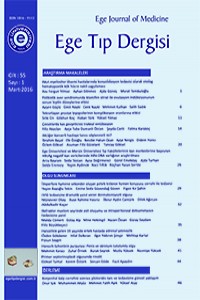Investigation of the presence of HBV-DNA in HBsAg negative blood donors admitted to the blood transfusion centers of the Faculty of Medicine of Ege University and Mersin University
Abstract
Aim: Hepatitis B virus (HBV) remains important among the agents of blood transmitted infections. Although increased sensitivity of serological tests, detection of HBV-DNA by nucleic acid tests (NAT) techniques, especially by the individual NAT (ID-NAT) techniques for safe blood transfusion came into question. Materials and Methods: A total of 4352 HBsAg negative volunteer-donors in ages of 18-65 years admitted to the Blood Transfusion Centers of Ege University Faculty of Medicine and Mersin University Faculty of Medicine Hospital were included in the study between April 2010 and January 2011. The samples of the donors were tested with real-time polymerase chain reaction (RT-PCR) in order to detect HBV-DNA. Results: Following HBV-DNA screening, only two positive serum results were found. Test was repeated on two positive samples with both the same and an alternative method. Repeated tests resulted negative; therefore all samples were assessed as HBV-DNA negative. In all samples of HBsAg negative donors from two different centers, HBV-DNA was found to be negative. Conclusion: The number of blood donors included in the study and low seroprevalence of the centers could be the reason for no detection of occult HBV. Turkish Red Crescent routine NAT studies that began in 2014 will give appropriate data for occult HBV in our region.
Ege Üniversitesi ve Mersin Üniversitesi Tıp Fakültelerinin kan merkezlerine başvuran HBsAg negatif kan vericilerinde HBV-DNA varlığının araştırılması
Abstract
Amaç: Kan yoluyla bulaşan enfeksiyon etkenleri arasında hepatit B virüsü (HBV) önemini korumaktadır. Serolojik testlerin duyarlılığının arttırılmasına rağmen güvenli kan transfüzyonu için kanda HBV-DNA varlığını saptayan nükleik asit testi (NAT) uygulamaları, özellikle de tek tek örneklere uygulanan NAT (ID-NAT) uygulamaları gündeme gelmiştir. Gereç ve Yöntem: Ege Üniversitesi Tıp Fakültesi Kan Merkezi ve Mersin Üniversitesi Tıp Fakültesi Sağlık Araştırma Uygulama Hastanesi Kan Merkezi'ne Nisan 2010 ile Ocak 2011 tarihleri arasında başvuran 18–65 yaşları arasındaki 4352 HBsAg negatif kan vericisinin serum örnekleri incelenmek üzere çalışmaya alındı. Kan vericilerinin örneklerinde HBV-DNA'yı saptamak amacıyla gerçek zamanlı polimeraz zincir reaksiyonu (RT-PCR) testi uygulandı. Bulgular: Çalışılan örneklerden sadece 2 serumda HBV-DNA şüpheli pozitif olarak saptandı. İki pozitif sonuç aynı yöntemle iki kez ve farklı alternatif yöntemlerle doğrulamak amacıyla tekrarlandı. Tekrarlanan örneklerin negatif bulunması sonucunda örneklerin tümünde HBV-DNA negatif olarak değerlendirildi. İki ayrı merkezden alınan HBsAg negatif kan vericilerinin tüm örneklerinde HBV-DNA negatif bulundu. Sonuç: Çalışmaya alınan kan vericilerin sayısı ve merkezlerdeki düşük seroprevalans gizli HBV görülmemesinin nedeni olabilir. Türk Kızılayı'nın 2014'de başlayan rutin NAT çalışmaları bölgemizdeki gizli HBV verilerini daha net ortaya çıkaracaktır.
Details
| Other ID | JA46HB95YK |
|---|---|
| Journal Section | Research Articles |
| Authors | |
| Publication Date | March 1, 2016 |
| Submission Date | March 1, 2016 |
| Published in Issue | Year 2016 Volume: 55 Issue: 1 |
Ege Journal of Medicine enables the sharing of articles according to the Attribution-Non-Commercial-Share Alike 4.0 International (CC BY-NC-SA 4.0) license.

